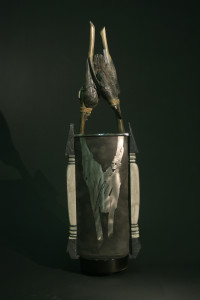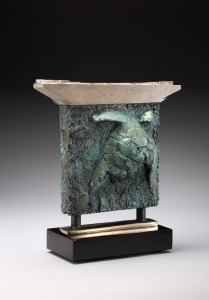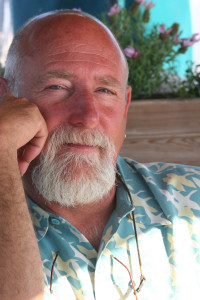I still bear the scars of that explosion 40 years later. A sappy piñon log erupted just as I bent to retrieve my foil-wrapped potato from the glowing embers of our campfire on Jacob’s Ladder, outside Grand Junction, Colorado. A couple of hot coals lodged between my coat collar and neck, where they danced and sizzled for an eternity. It was early spring more than 50 years ago when Walt and I chose that site to park our Cushman motor-scooters (remember those? Shriners used to ride ‘em in parades, wearing their fez, maybe still do). We were doing something completely normal for 14 year-old boys in those days: ride our scooters out of town, up into the mesa country, then off across the desert to camp for the weekend. At this time the two lane Highway 6 was the main route from Grand Junction to Denver. Interstate 70 was barely a gleam in Eisenhower’s eye.
If we tried that today, we’d be violating numerous federal and state laws, and there’d be someone close enough to report us, assault us, or arrest us. These new regulations are probably necessary because there are just too many of us. Because of our own proliferation, this level of control is necessary, if not insufficient. Artists my age and older are probably the last artists to have had almost unfettered access to the American wilderness.
We grew up steeped in outdoor survival, wandering the deserts and mountains like today’s children wander a city park. Actually, no sane parent would allow a child to wander a city park unsupervised today. But we camped, fished, hunted, and absorbed the wild as if it were the very air. My sculpture is a symbolic exercise, created by a contemporary man with primitive experience. It is an attempt to make my experience of the American wilderness accessible to anyone viewing the artwork. It is also my attempt to reconcile what was, what is, and what will be.

Previously on display in Environmental Impact
Bound is a graphic exploration of the connectivity of all things. These ravens, which often represented the Trickster/Creator, are bound to dead trees in a denuded forest. In this case I used the mirror image of these bound ravens to show the bound skeletal remains of human bodies; the devastating consequence of ignoring the changing climate and environment around us.
Since those childhood adventures I have moved out into the wider world and in the process watched more and more of that primitive world disappear. For instance, scuba diving in the mid-seventies revealed the incredible vistas just out of sight below the sea surface. Those coral reefs and vast schools of fish were a common scene all over the world, and I was privileged to explore them in the Caribbean, Hawaii, and lately in Mexico. When I returned to Hawaii in the early years of this century, the reefs I was anticipating were almost gone. There was mostly only dead coral, rocks and sand, with a few fish wandering in an endless search for food. Oh, and there were also hordes of sunburned tourists ruining what was left by walking on the remaining coral instead of swimming above it.
My wife and I moved aboard our sailboat in 1998 and have since traveled extensively on the Pacific Ocean off the coasts of the United States, Mexico, and the Sea of Cortez. We have seen the ocean become progressively cloudier and emptier. The Sea of Cortez (between the Baja Peninsula and mainland Mexico) still has mostly clear water and some surviving coral reefs. The fish population is rapidly decreasing however, due mostly to climate change and overfishing to supply the flourishing tourist industry in Mexico and beyond. The waters also are affected in places by past dumping of raw sewage. A friend of ours, Jessica Reilly, PhD, is now conducting research (from her sailboat) documenting the effect of climate change on Mexican and Latin American rural coastal communities. You can see and read the findings in her ongoing blog as she sails the Sea of Cortez, and now Pacific Mexico.

Previously on display in Environmental Impact
In the “present” a green sea turtle is ghosting through the ocean, in its element. On the other side the symbol of that turtle is cruising up the side of a flooded building.
We are also seeing an alarming increase in severe weather along these coasts. This is causing a burden to the fishermen and maritime residents, as well as the recreational boaters. Mexico is waking up to these problems slowly, but is reacting in many positive ways. They have made a national goal to cut emissions, and have begun investing in alternative energy sources. For example, on the smaller scale, solar water heaters are cheaper and more abundant in Guanajuato in the central Mexican mountains than in the US.
Exhibits such as Environmental Impact provide a stunning, in your face portrayal of the impact our cavalier attitude towards our one and only planet is having. The ideas portrayed by these and other artists are much more visible and effective than printed words, or insipid television coverage of these changes.
As I rub the back of my neck, feeling the scars of my youth, I’m reflecting on the scarring of our world, visible and hidden. The clear cutting of our forests hidden from public view by a narrow border of trees along the highways of the Pacific Northwest. In Mexico and the US, among others, huge pit mines are often hidden from the public by mountain ridges. Here in Guanajuato the trees surrounding the city were clear cut by the Spaniards 500 years ago, and they have still not grown back. We have a responsibility worldwide to start healing these scars, and not injure our home any further.
Stories and photos of our own recent travels can be found here. © 2016 Chapel
The works by Chapel featured above were on display in the traveling museum exhibition Environmental Impact, which closed at St. Mary’s College on May 1, 2016. A sequel is scheduled for January 5 to May 26, 2019 at the North Carolina Arboretum in Ashville, NC. Chapel is a Signature Member of the Society of Animal Artists.
 Chapel was born in 1948 in Glenwood Springs, Colorado, and raised in Grand Junction. He attended Mesa College on an art scholarship, then continued his education in metal smithing (specializing in jewelry) at Colorado State University. Chapel and his wife have spent time living on the Chesapeake Bay, in Northern California, and aboard their forty-six food Morgan ketch rigged sailboat, Two Shadows, based out the San Francisco Bay area. In the spring of 2013 they set sail on an extended voyage, and have since re-settled in Guanajuato, Mexico.
Chapel was born in 1948 in Glenwood Springs, Colorado, and raised in Grand Junction. He attended Mesa College on an art scholarship, then continued his education in metal smithing (specializing in jewelry) at Colorado State University. Chapel and his wife have spent time living on the Chesapeake Bay, in Northern California, and aboard their forty-six food Morgan ketch rigged sailboat, Two Shadows, based out the San Francisco Bay area. In the spring of 2013 they set sail on an extended voyage, and have since re-settled in Guanajuato, Mexico.
This post is part of the MAHB’s Arts Community space –an open space for MAHB members to share, discuss, and connect with artwork processes and products pushing for change. Please visit the MAHB Arts Community to share and reflect on how art can promote critical changes in behavior and systems and contact Erika with any questions or suggestions you have regarding the new space.
MAHB-UTS Blogs are a joint venture between the University of Technology Sydney and the Millennium Alliance for Humanity and the Biosphere. Questions should be directed to joan@mahbonline.org
MAHB Blog: https://mahb.stanford.edu/blog/the-vanishing-experience/
The views and opinions expressed through the MAHB Website are those of the contributing authors and do not necessarily reflect an official position of the MAHB. The MAHB aims to share a range of perspectives and welcomes the discussions that they prompt.

